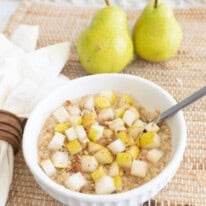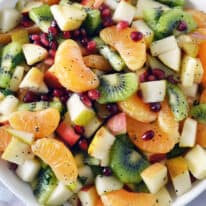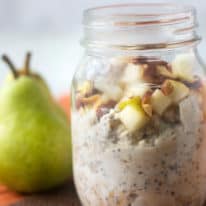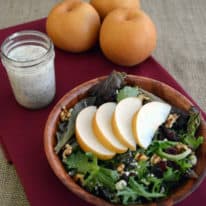
Seasonality:
- Pears can be found in most grocery stores year-round with the first pears harvested in August each year
Health Benefits of Pears:
- Pears are an excellent source of fiber, with 6 grams per serving (medium pear)
- Pears are a good source of vitamin C
- A medium-sized pear has 100 calories, is fat-free, sodium free, and cholesterol free.
- They also contain potassium and antioxidants.
Learn How to Select Pears:
- Select pears that are free of bruises or blemishes.
- Bartlett pears will change from green to yellow when they ripen, but most pears do not change significantly. For all other pears, check the neck to know they are ripe. Press with your thumb at the stem area and if it gives to pressure, it is ripe and ready to eat. If it is firm, leave it at room temperature to ripen. Ripe pears can be stored in the refrigerator to enjoy later.
Ways to Store Pears:
- Ripen pears at room temperature, on the counter or in a fruit bowl. Do not refrigerate unripe pears.
- Once they are ripe, they can be stored in the refrigerator to extend their life by several days.
- Wash pears carefully before eating, using a scrub brush by the stem and bottom ends.
How to Prepare Pears:
- Always wash before eating.
- Pears can be eaten whole like an apple, sliced or chopped.
Fun Facts About Pears:
- Pears do not ripen on the tree. They’re harvested when they’re mature, not ripe. Pear also ripen from the inside out.
- There are over 3000 varieties of pears worldwide.
- The United States is one of the largest producers of pears in the world.
Learn more at USA Pears
Get additional resources in our Nutrition Education Center




























